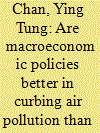|
|
|
Sort Order |
|
|
|
Items / Page
|
|
|
|
|
|
|
| Srl | Item |
| 1 |
ID:
175033


|
|
|
|
|
| Summary/Abstract |
The environmental impacts of macroeconomic policies, and their interaction with climate policies are under-researched in the existing literature. This paper compares the effectiveness of standard macroeconomic tools (fiscal and monetary policies) with carbon taxation in curbing air pollution by using an environmental dynamic stochastic general equilibrium (E-DSGE) model. We show how government expenditure, interest rate, and carbon tax rate should vary over time in order to stabilize carbon emission levels. We find that (i) while all the aforementioned policies could stabilize carbon emissions, their underlying mechanisms are different. Fiscal, monetary, and carbon tax policies, uniquely and respectively, lead to a reduction in abatement effort, income tax revenue, and general price level. (ii) With economic expansions driven by total factor productivity (TFP) shocks, fiscal policy is the only policy that could maintain the emission levels and simultaneously improve household welfare in term of consumption and labor. (iii) Regarding the interaction between carbon and macroeconomic policies, carbon taxation should complement monetary policy, while it should not respond to fiscal policy.
|
|
|
|
|
|
|
|
|
|
|
|
|
|
|
|
| 2 |
ID:
107505


|
|
|
|
|
| Publication |
2011.
|
| Summary/Abstract |
In an stylized endogenous growth economy with a negative externality created by CO2 emissions and in which abatement activities are made by private firms, we find a wide range of dynamically feasible green tax reforms yielding the double dividend without any need to assume a complex production structure or tax system, or a variety of externalities in production. As a remarkable finding, we obtain certain scenarios in which increasing the emissions tax up to the Pigouvian level and removing completely the income tax is dynamically feasible and, also, it is the second-best reform. Hence, as a difference to previous literature, in these scenarios the first-best tax mix is implementable, allowing for the elimination of both environmental and non-environmental inefficiencies. Our result arises because of the consideration of public debt issuing and the management of the government budget balance with an intertemporal perspective. The result is obtained for an intermediate range of environmental bearing in preferences, the valid range being contingent on the pre-existing income tax rate. The type of tax reform that we propose could also be implemented for different energy taxes.
|
|
|
|
|
|
|
|
|
|
|
|
|
|
|
|
| 3 |
ID:
125557


|
|
|
|
|
| Publication |
2013.
|
| Summary/Abstract |
In the presence of learning spillovers related to renewable energy technologies, an optimal strategy to mitigate climate change should complement an emissions tax by a subsidy for renewables. This article addresses the question how such subsidy should be designed. It is shown that the widely-used approach of a revenue-neutral fixed feed-in tariff can yield an optimal outcome under restrictive conditions only. It has to be adapted continuously as the electricity price changes. Moreover, funding the tariff by a surcharge on the electricity price has important implications for the design of the emission tax. The optimal tax rate has to be below the Pigovian level, differentiated across fossil fuels and adapted over time as the patterns of technological development change. These requirements may pose a formidable challenge for practical decision-making. However, it is important to point out that the eventual choices made with respect to the design and funding of a feed-in tariff have to be based on a careful and more comprehensive policy assessment, including, inter alia, economic effects beyond the electricity sector and existing institutional constraints.
|
|
|
|
|
|
|
|
|
|
|
|
|
|
|
|
|
|
|
|
|